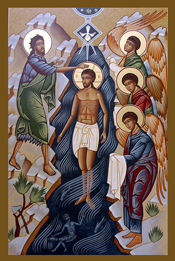January 6
The Feast of Theophany celebrates an historical event – the baptism of Christ by John the Baptist in the River Jordan. Sometimes called the Feast of Epiphany (from the Greek meaning ‘appearance’ or ‘manifestation’), Theophany (from the Greek meaning the appearance or manifestations of God) reveals the different materializations of God (Theophanies) to men in the Person of Jesus Christ.
At the top of the Icon of Theophany, the half-circle at the top symbolizes the opening of heaven and signifies God’s presence and witness at the great event. Since God the Father cannot be seen, there is no image of Him, but he is nonetheless present. From the circle descends a single ray of light which divides into three distinct rays, representing the Holy Trinity. Descending through the rays of light is the Holy Spirit, depicted as a dove. Christ stands totally immersed in the waters of the River Jordan with his right hand blessing the waters. John the Baptist is depicted with his right hand on the head of Christ and his left hand in a gesture of prayer. At the right are three angels standing bowed in reverence with their hands covered as a symbol of submission.
The Feast of Theophany is one of the oldest church festivals (St. Clement of Alexandria, circa 215 A.D. mentions it) and was originally a collective feast, celebrating the Nativity, Baptism, and other miracles of Christ. Later, the celebration of the Nativity was moved to December 25 and January 6 became reserved for the celebration of the Baptism of Our Lord.
Closely connected with the Feast of Theophany is the Great Water Blessing (or, Blessing of Jordan Water), which occurs twice, one the vigil and on the feast day. From early times people have cherished the custom of the Blessing and have attached great significance to the Blessed Waters, which they keep in their homes as something possessing great sanctifying powers. It is also customary for people to drink of the Holy Water for the “purification of their souls and bodies and cure of their weaknesses.”
Also included during the blessing of the waters is the sanctification of homes. Just as the faithful cleanse their souls at least once a year, and the church is blessed with newly blessed water each year, so are the homes of the faithful blessed to invoke God’s protection.
